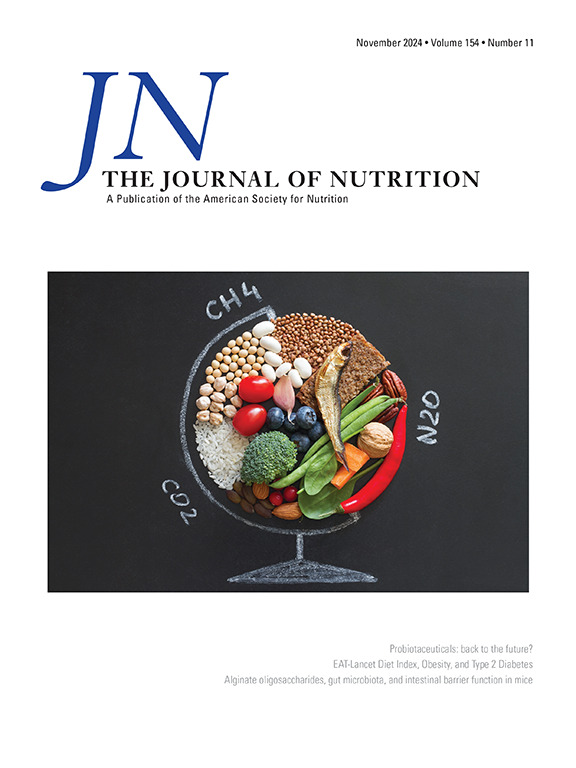Dietary Intake Is Associated with Biomarkers of Lead, Arsenic, and Cadmium in a Cohort of Mexican Adolescents
IF 3.8
3区 医学
Q2 NUTRITION & DIETETICS
引用次数: 0
Abstract
Background
Lifestyle changes during adolescence can impact dietary habits and, subsequently, exposure to heavy metals.
Objectives
We aimed to evaluate the associations between food group intakes and metal exposures in a cohort of adolescents.
Methods
This study included 416 adolescents from Mexico City aged 10–18. Sociodemographic information at birth and repeated measurements of diet, anthropometry, and metal exposures were collected over 2 visits 3.5 ± 0.40 y apart (n = 514). Food groups (n = 31) were created based on the characteristics of 119 food frequency questionnaire items and metal dietary sources. Linear mixed-effect models were used to evaluate the associations between food group intake and exposure to blood lead, urinary arsenic, and urinary cadmium for the overall population (main models) and stratified by sex. Models were adjusted for age, sex (main models), maternal age, socioeconomic status, and specific gravity (only for urinary metals).
Results
Fruit intake in girls {2.63% [95% confidence interval (CI): 0.22%, 5.10%]}, and candy in boys [2.13% (95% CI: 0.40%, 3.88%)] and in the whole population [1.38% (95% CI: 0.16%, 2.61%)] were associated with higher blood lead levels. Additionally, leafy greens intake was associated with higher blood lead [10.75% (95% CI: –0.01%, 22.66%)]. Chicken intake in girls was associated with 5.95% (95% CI: 0.38%, 11.84%) higher urinary cadmium. Similarly, the intake of homemade sugar-sweetened beverages in girls [4.42% (35% CI: 0.13%, 8.89%)], and in the whole population [4.14% (95% CI: 1.42%, 6.94%)], was associated with higher urinary cadmium. Moreover, the intake of fish and seafood groups was positively associated with blood lead, urinary arsenic, and urinary cadmium.
Conclusions
We observed associations between food group intake and metal exposures in a group of Mexican adolescents using repeated measures of both outcomes and exposures. We also found that some of these associations varied by sex.
在一组墨西哥青少年中,饮食摄入与铅、砷和镉的生物标志物相关
背景:青春期生活方式的改变会影响饮食习惯,进而影响重金属暴露。我们的目的是评估青少年队列中食物组摄入量与金属暴露之间的关系。方法:本研究包括416名来自墨西哥城的10-18岁青少年。出生时的社会人口统计信息以及饮食、人体测量和金属暴露的重复测量在间隔3.5±0.40年的两次访问中收集(n=514)。根据119个食物频率问卷项目和金属膳食来源的特征,建立食物组(n=31)。线性混合效应模型用于评估食物组摄入与总体人群(主要模型)血铅、尿砷和尿镉暴露之间的关系,并按性别分层。对模型进行了年龄、性别(主要模型)、母亲年龄、社会经济地位和比重(仅针对尿金属)的调整。结果:女孩摄入水果(2.63% [95% CI: 0.22, 5.10],男孩摄入糖果(2.13% [95% CI: 0.40, 3.88])和整个人群(1.38% [95% CI: 0.16, 2.61])与较高的血铅水平相关。此外,绿叶蔬菜摄入与较高的血铅有关(10.75% [95% CI: -0.01, 22.66])。女孩摄入鸡肉与5.95% (95% CI: 0.38, 11.84)高尿镉相关。同样,女孩(4.42% [35% CI: 0.13, 8.89])和整个人群(4.14% [95% CI: 1.42, 6.94])自制含糖饮料的摄入与尿镉含量升高有关。此外,摄入鱼类和海鲜组与血铅、尿砷和尿镉呈正相关。结论:我们观察了一组墨西哥青少年的食物组摄入和金属暴露之间的关联,使用了结果和暴露的重复测量。我们还发现,其中一些关联因性别而异。
本文章由计算机程序翻译,如有差异,请以英文原文为准。
求助全文
约1分钟内获得全文
求助全文
来源期刊

Journal of Nutrition
医学-营养学
CiteScore
7.60
自引率
4.80%
发文量
260
审稿时长
39 days
期刊介绍:
The Journal of Nutrition (JN/J Nutr) publishes peer-reviewed original research papers covering all aspects of experimental nutrition in humans and other animal species; special articles such as reviews and biographies of prominent nutrition scientists; and issues, opinions, and commentaries on controversial issues in nutrition. Supplements are frequently published to provide extended discussion of topics of special interest.
 求助内容:
求助内容: 应助结果提醒方式:
应助结果提醒方式:


